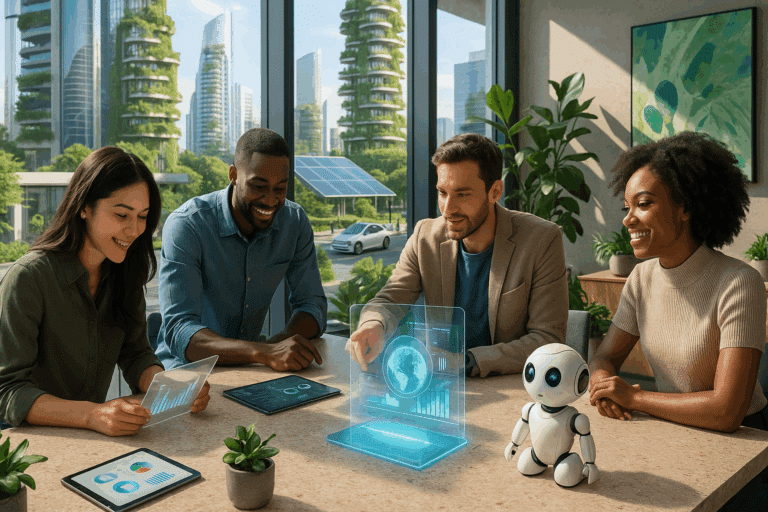Today, corporate social responsibility (CSR) and transparency have emerged as fundamental aspects driving the revolution in supply chain management. 🌎 But how exactly are they reshaping the industry and why should you, as a business leader, care?
In this comprehensive guide, we’re going to take an in-depth look at how the integration of CSR and transparency are transforming supply chains for a better future. Whether you’re a supply chain manager, an executive, or simply interested in the trends shaping global trade, buckle up for a thrilling exploration of these emerging paradigms. 🚀
The subject of CSR and transparency in supply chains is as vast as it is captivating. So, to navigate it seamlessly, we’ll break it down into easily digestible sections. We’ll begin by defining what we mean by CSR and transparency and why they have become so crucial in today’s business environment. Then we’ll dive into the ways these concepts are revolutionizing supply chains, along with real-world examples. Finally, we’ll wrap things up by discussing the future of supply chains in light of these changes. 🔍
But before we get started, let’s set the stage by examining the current state of supply chains. Globalization and technology have made them more complex than ever, but also more susceptible to scrutiny. In the information age, consumers, investors, and regulators demand accountability and transparency from companies. The “out of sight, out of mind” approach to managing supply chains simply doesn’t cut it anymore. 🌐
Today, businesses are expected to ensure their supply chains are not only efficient, but also socially responsible and transparent. In other words, companies can no longer afford to ignore the social, environmental, and economic impacts of their supply chain activities. Enter CSR and transparency. These two factors have emerged as game-changers, enabling businesses to meet these heightened expectations while also reaping benefits such as improved reputation, increased customer loyalty, and greater operational efficiency. 💡
So, if you’ve been pondering the future of supply chains, or wondering how your business can adapt to these evolving expectations, you’re in the right place. This article will not only help you understand the role of CSR and transparency in supply chains, but also provide you with actionable insights you can apply to your own business. So, let’s embark on this journey and discover how these two aspects are paving the way for a more sustainable and ethical business landscape. 🌿
Just a heads up, though, this article isn’t a quick read. It’s a comprehensive, deep dive into the subject matter that requires a good chunk of your time and attention. But don’t let that deter you. We promise the insights you’ll gain will be worth it. After all, knowledge is power, especially in the fast-paced, ever-evolving world of supply chains. Ready? Let’s dive in. 🌊
Unveiling the Magic: The Interplay between CSR and Transparency in Modern Supply Chains
Today’s increasingly globalized world presents myriad challenges for businesses, particularly regarding supply chain management. More than ever before, companies are being held accountable not just for their direct actions, but for those of their suppliers. Corporate Social Responsibility (CSR) and transparency have emerged as crucial aspects in this sphere, revolutionizing supply chains for a better future. Let’s dive deeper into how this is happening.
CSR is a business model that integrates self-regulating mechanisms whereby a business monitors and ensures its adherence to the law, ethical standards, and international norms. By implementing a robust CSR strategy, businesses can contribute towards sustainable economic development, working hand-in-hand with their employees, their families, and the local community at large. The video “What is CSR?” by Animation Desk provides a comprehensive overview of this concept. (Watch it here)
Meanwhile, transparency in supply chains is all about providing clear, accessible, and accurate information about the production processes, sourcing, and overall journey of products and services from inception to the customer. It’s about shedding light on the ‘behind-the-scenes’ to foster trust and ensure ethical practices.
CSR and Transparency: The Dynamic Duo Reshaping Supply Chains
CSR and transparency in supply chains are interlinked concepts, with each bolstering the effectiveness of the other. CSR initiatives often require high levels of transparency to be effectively implemented and evaluated. Conversely, the pursuit of transparency can often lead to the identification of areas where CSR can be improved.
The link between CSR and supply chain transparency is made evident in initiatives such as the ‘Fair Trade’ movement. This initiative promotes better trading conditions and sustainable farming, ensuring that small-scale producers receive a fair price for their goods. It’s an excellent example of CSR in action. The movement’s success is underpinned by transparency, with clear labeling and certification processes allowing consumers to make informed choices.
As we navigate deeper into the 21st century, the demand for CSR and transparency in supply chains continues to grow. Stakeholders – from consumers to investors – are increasingly considering these factors when making decisions. Thus, businesses are recognizing that adopting CSR and transparency practices isn’t just ethically sound – it can be a strategic move too.
🔍 Case Study: Patagonia’s Transparent and Responsible Supply Chain
Outdoor clothing company Patagonia serves as an exemplary model of CSR and transparency in action. They have long been lauded for their ethical approach to business, with substantial efforts in place to ensure transparency throughout their supply chain. (Check out the video “Patagonia’s Journey to Circular Economy” by Patagonia on YouTube for more)
One notable initiative is ‘The Footprint Chronicles,’ a section on Patagonia’s website that allows customers to track the environmental impact of their products, from raw materials to production and delivery. This degree of transparency is unmatched in the industry and highlights how CSR and transparency can work in tandem to revolutionize supply chains.
Through initiatives like these, Patagonia demonstrates that businesses can indeed play a significant role in driving positive change. Their commitment to CSR and transparency has not only improved their supply chain but also strengthened their brand image and customer loyalty.
How CSR and Transparency are Shaping Future Supply Chains: A Comparative Analysis
CSR and transparency are not mere buzzwords – they are powerful tools capable of reshaping supply chains for a more sustainable and ethical future. Let’s look at how they impact various aspects of supply chains.
| Aspect | Impact of CSR | Impact of Transparency |
|---|---|---|
| Ethical sourcing | Encourages responsible sourcing and reduces exploitation. | Sheds light on unethical sourcing practices, driving demand for change. |
| Environmental impact | Promotes sustainable practices and reduction of carbon footprint. | Highlights the environmental impact of production processes, driving demand for greener alternatives. |
| Employee welfare | Ensures fair treatment and safe working conditions for employees. | Exposes unfair labor practices, prompting demand for better working conditions. |
Stepping Up: How to Foster CSR and Transparency in Your Supply Chain
Regardless of your business’s size or industry, integrating CSR and transparency into your supply chain is both possible and beneficial. Here are some starting points:
- Define your values: Identify what matters to your business and align your CSR initiatives accordingly.
- Be proactive, not reactive: Don’t wait for a crisis to prompt change. Actively seek out ways to improve your CSR and transparency.
- Communicate openly: Share your CSR initiatives and supply chain information with stakeholders. Honesty builds trust.
- Collaborate: Work with suppliers, NGOs, and industry groups to drive change. Collective action yields stronger results.
Remember, CSR and transparency aren’t overnight transformations. They require time, effort, and ongoing commitment. But the benefits – both for your business and for society at large – are well worth the investment.
Now, it’s your turn to take a step towards a more responsible, transparent, and ultimately, successful business. Let the revolution begin!

Conclusion
In conclusion, it is clear that the world of software engineering is continually evolving and adapting to meet the demands of our technologically advanced society. From the basic principles of coding, to more complex concepts like the Internet of Things (IoT), Artificial Intelligence (AI) and Machine Learning (ML), we have delved into the intricacies of each topic and demystified them, providing a comprehensive understanding of their applications and their potential impact on our daily lives.
As we’ve seen, coding is the foundation of all software applications. The ability to write clear, efficient code is a skill that will serve you well in any tech-related field. The languages of JavaScript, Python, C++ among others, have been highlighted in this article as the tools of the trade in the tech world. Understanding how to use these languages to create effective solutions to problems is a fundamental skill in this era of digital technology.
The rise of IoT is also a significant development in the tech world. As we’ve discussed, IoT devices are everywhere, from smart home systems to wearable tech and industrial applications. Understanding how these devices communicate with each other and the potential security risks involved is crucial for anyone working in the tech industry.
AI and ML have also been given due attention in this article. These two technologies are revolutionising industries across the globe, making it a must-know subject for anyone working in or studying technology and software engineering. AI’s ability to mimic human cognitive functions and ML’s capacity to learn from data patterns without being explicitly programmed to do so is indeed fascinating, underscoring the vast potential and significance of these technologies.
The importance of maintaining up-to-date knowledge in these ever-evolving fields cannot be overstated. As technology continues to advance at a rapid pace, the ability to adapt and learn new skills will prove invaluable. 🚀
It is my hope that this article has provided you with a deeper understanding of these complex topics, and inspired you to continue learning and growing in your technological pursuits. I encourage you to share this article with your peers and engage in a discussion about these exciting developments in the tech world. 🌐
Remember, as Albert Einstein once said, “The more I learn, the more I realize how much I don’t know.” So keep learning, keep exploring, and keep pushing the boundaries of what is possible.
Please feel free to leave comments or questions in the section below. Your feedback is always appreciated.
Looking for more resources? I recommend checking out the following links for more information on these topics:
– [Coding](#)
– [Internet of Things](#)
– [Artificial Intelligence](#)
– [Machine Learning](#)
Lastly, don’t forget to apply what you’ve learned! Incorporate these concepts into your work or studies, and you’ll be sure to see the benefits. 💡
References:
– [Reference 1](#)
– [Reference 2](#)
– [Reference 3](#)
Remember, the world of technology is vast and ever-changing. Stay curious, stay informed, and most importantly, never stop learning. 🎓
Until next time,
Rodrigo Almeida



